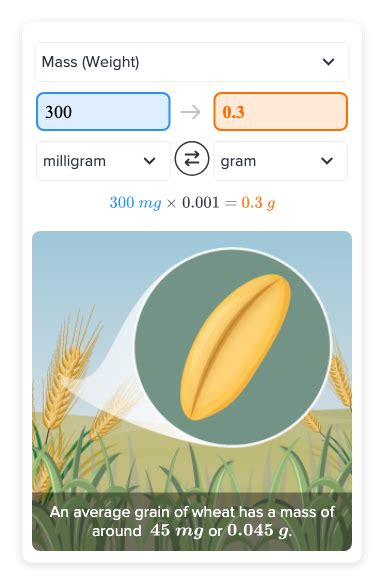How Many Grams In 300 Milligrams
Kalali
Mar 28, 2025 · 4 min read

Table of Contents
How Many Grams in 300 Milligrams? A Comprehensive Guide to Metric Conversions
Understanding metric conversions is crucial in various fields, from cooking and medicine to science and engineering. One common conversion involves milligrams (mg) and grams (g), units used to measure mass or weight. This comprehensive guide will delve into the conversion of 300 milligrams to grams, explaining the process in detail and providing helpful context for understanding the metric system.
Understanding the Metric System
The metric system, also known as the International System of Units (SI), is a decimal system based on powers of 10. This makes conversions between units relatively straightforward. The key to understanding these conversions lies in recognizing the prefixes used to denote multiples or fractions of the base unit.
Key Prefixes in the Metric System
Before we tackle the conversion of 300 milligrams to grams, let's review some key prefixes:
- Kilo (k): Represents 1000 times the base unit (1 kg = 1000 g)
- Hecto (h): Represents 100 times the base unit
- Deka (da): Represents 10 times the base unit
- Deci (d): Represents 1/10 of the base unit (1 dL = 0.1 L)
- Centi (c): Represents 1/100 of the base unit (1 cm = 0.01 m)
- Milli (m): Represents 1/1000 of the base unit (1 mm = 0.001 m)
In our case, we are focusing on the relationship between grams (the base unit for mass in this context) and milligrams.
Converting 300 Milligrams to Grams
The core relationship we need to remember is:
1 gram (g) = 1000 milligrams (mg)
This means that one gram is equal to one thousand milligrams. To convert milligrams to grams, we need to divide the number of milligrams by 1000.
Therefore, to find out how many grams are in 300 milligrams, we perform the following calculation:
300 mg / 1000 mg/g = 0.3 g
Therefore, there are 0.3 grams in 300 milligrams.
Practical Applications of this Conversion
This seemingly simple conversion has practical applications across numerous fields. Let's explore some examples:
1. Medicine and Pharmacology:
Dosage instructions for medication are often expressed in milligrams. Understanding the conversion to grams is crucial for accurate dosage calculations and ensuring patient safety. For instance, a doctor might prescribe 300mg of a certain drug, and a pharmacist or nurse needs to ensure the correct amount is administered. The knowledge that 300mg equals 0.3g facilitates the accurate dispensing and administration of the medicine.
2. Chemistry and Science:
In laboratory settings, precise measurements are paramount. Scientists frequently use milligrams to measure small quantities of substances, and converting these measurements to grams is essential for recording data accurately and performing calculations in scientific experiments. Using consistent units ensures that experimental results are reliable and reproducible.
3. Food and Nutrition:
Nutritional information on food labels often lists the amounts of various nutrients in milligrams. Understanding the relationship between milligrams and grams allows consumers to better understand the quantities of nutrients they are consuming. This knowledge empowers informed decisions about dietary choices.
4. Engineering and Manufacturing:
Precise measurements are also crucial in engineering and manufacturing, where even small discrepancies can significantly impact the functionality of a product. Converting between milligrams and grams helps ensure accuracy in design specifications, production processes, and quality control. This accuracy ensures the reliability and safety of the final product.
5. Everyday Life:
While less frequent than in specialized fields, understanding metric conversions can be beneficial in everyday life. For instance, if you’re following a recipe that calls for a certain amount of a spice in milligrams, you can easily convert it to grams for more convenient measuring using a standard kitchen scale.
Beyond 300 Milligrams: Mastering Metric Conversions
While this article focuses on converting 300 milligrams to grams, the principles discussed can be applied to any milligram-to-gram conversion. Simply divide the number of milligrams by 1000 to obtain the equivalent in grams.
For instance:
- 500 mg = 0.5 g
- 1500 mg = 1.5 g
- 10,000 mg = 10 g
Conversely, to convert grams to milligrams, multiply the number of grams by 1000.
For example:
- 2 g = 2000 mg
- 0.75 g = 750 mg
- 0.01 g = 10 mg
Tips for Accurate Conversions
To minimize errors when performing conversions:
- Double-check your calculations: Always verify your work to ensure accuracy.
- Use a calculator: For larger numbers or more complex conversions, a calculator can be helpful.
- Understand the context: Pay attention to the units involved and ensure you're using the correct conversion factor.
- Practice regularly: The more you practice metric conversions, the more comfortable and proficient you will become.
Conclusion
Understanding how many grams are in 300 milligrams – and more broadly, mastering metric conversions – is a valuable skill with wide-ranging applications. From scientific research to everyday life, accurate conversions ensure precision, reliability, and informed decision-making. By understanding the foundational principles of the metric system and practicing conversions, you can confidently navigate the world of measurements and utilize this knowledge to your advantage. Remember the key relationship: 1 gram equals 1000 milligrams. With this knowledge, you're equipped to confidently tackle any milligram-to-gram conversion.
Latest Posts
Latest Posts
-
Lines Of Symmetry Of A Hexagon
Mar 31, 2025
-
16 Celsius Is What In Fahrenheit
Mar 31, 2025
-
What Is A Bird That Is A Carnivore
Mar 31, 2025
-
Cuanto Es El 10 De 3000
Mar 31, 2025
-
4 3 As A Mixed Number
Mar 31, 2025
Related Post
Thank you for visiting our website which covers about How Many Grams In 300 Milligrams . We hope the information provided has been useful to you. Feel free to contact us if you have any questions or need further assistance. See you next time and don't miss to bookmark.
